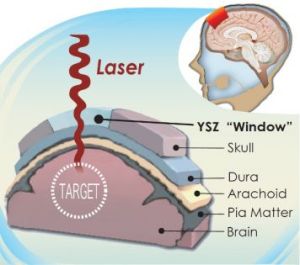Sep 4 2013
A team of University of California, Riverside researchers have developed a novel transparent skull implant that literally provides a “window to the brain”, which they hope will eventually open new treatment options for patients with life-threatening neurological disorders, such as brain cancer and traumatic brain injury.
 A cross section of the head that shows how the transparent skull implant works. Credit: Mayo Kodera
A cross section of the head that shows how the transparent skull implant works. Credit: Mayo Kodera
The team’s implant is made of the same ceramic material currently used in hip implants and dental crowns, yttria-stabilized zirconia (YSZ). However, the key difference is that their material has been processed in a unique way to make it transparent.
Since YSZ has already proven itself to be well-tolerated by the body in other applications, the team’s advancement now allows use of YSZ as a permanent window through which doctors can aim laser-based treatments for the brain, importantly, without having to perform repeated craniectomies, which involve removing a portion of the skull to access the brain.
The work also dovetails with President Obama’s recently-announced BRAIN (Brain Research through Advancing Innovative Neurotechnologies) Initiative, which aims to revolutionize the understanding of the human mind and uncover new ways to treat, prevent, and cure brain disorders. The team envisions potential for their YSZ windows to facilitate the clinical translation of promising brain imaging and neuromodulation technologies being developed under this initiative.
“This is a case of a science fiction sounding idea becoming science fact, with strong potential for positive impact on patients,” said Guillermo Aguilar, a professor of mechanical engineering at UC Riverside’s Bourns College of Engineering (BCOE).
Aguilar is part of 10-person team, comprised of faculty, graduate students and researchers from UC Riverside’s Bourns College of Engineering and School of Medicine, who recently published a paper “Transparent Nanocrystalline Yttria-Stabilized-Zirconia Calvarium Prosthesis” about their findings online in the journal Nanomedicine: Nanotechnology, Biology and Medicine.
Laser-based treatments have shown significant promise for many brain disorders. However, realization of this promise has been constrained by the need for performing a craniectomy to access the brain since most medical lasers are unable to penetrate the skull. The transparent YSZ implants developed by the UC Riverside team address this issue by providing a permanently implanted view port through the skull.
“This is a crucial first step towards an innovative new concept that would provide a clinically-viable means for optically accessing the brain, on-demand, over large areas, and on a chronically-recurring basis, without need for repeated craniectomies,” said team member Dr. Devin Binder, a clinician and an associate professor of biomedical sciences at UC Riverside.
Although the team’s YSZ windows are not the first transparent skull implants to be reported, they are the first that could be conceivably used in humans, which is a crucial distinction. This is due to the inherent toughness of YSZ, which makes it far more resistant to shock and impact than the glass-based implants previously demonstrated by others. This not only enhances safety, but it may also reduce patient self-consciousness, since the reduced vulnerability of the implant could minimize the need for conspicuous protective headgear.
In addition to Aguilar and Binder, authors of the paper are: Yasaman Damestani, a Ph.D. student working with Aguilar; B. Hyle Park, an assistant professor of bioengineering; Carissa L. Reynolds, a Ph.D. student working with Park; Javier E. Garay, an associate professor of mechanical engineering; Yasuhiro Kodera, a project scientist who works in Garay’s lab; Masaru P. Rao, an assistant professor of mechanical engineering; Jenny Szu, a lab technician in Binder’s lab; and Mike S. Hsu, a staff research associate in Binder’s lab.
This research was supported, in part, by the UC Riverside Chancellor’s Strategic Research Initiative.